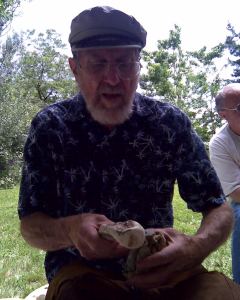by Katie Bowell, Curator of Cultural Interpretation
When I mentioned to an anthropologist friend of mine that I was planning to go to Bob Patten’s (he of world-renowned fame in replicating the fluted Folsom point) house for his annual “knap-in,” she laughed and told me I’d need 3 things: closed toe shoes (for all the big pieces of rock I’d drop on my feet), safety goggles (for all the flint chips I’d send into my eyes), and a beard (for all the…umm, I wasn’t actually sure). While I am the proud owner of several fake moustaches, sadly I had no beards. When I asked her why I’d need one she laughed and told me to wait and see.
When I arrived with Toby Swaford (the museum’s K-12 Education Coordinator) and my boyfriend Keith (whose background in physics and mechanical engineering made him more than geeky enough to enjoy a day of hitting rocks), the slightly cacophonous yet still melodic “ding” of stone falling on stone drew us to Bob’s backyard. And there it was: a tent full of mostly bearded men working on creating beautiful and complex stone tools. While having a beard hopefully isn’t a prerequisite for becoming a skilled flintknapper, I soon learned that having an incredible knowledge of all things “flintknappy” is.

Bob Patten demonstrates how to strike stone with an antler
In the few hours I spent with Bob and his fellow flintknappers, I was continuously impressed by how much these men knew. Whether it was materials, tools, history, archaeology, or other people’s research, I was surrounded by a group of men who had in their heads everything I have to keep looking up, and they were nice enough to answer all my questions. I (foolishly) got into an argument with Greg Nunn, considered by Bob to be the world expert in Danish flintknapping, over the historical appropriateness of using of copper-tipped tools in his work, and he promptly schooled me on the history of the transition from the Stone Age to the Bronze Age in Denmark. I lost that argument.

Bob shows Toby what to do

Toby gets ready to strike

Contact!
The highlight of my day was getting the chance to try flintknapping myself. It seemed easy enough: hit a rock with another rock. Nope. Bob handed me my own hunk of rock, a hammer stone, and then proceeded to mock my too-slow strike. After a few misses I finally got a hit and over the next couple minutes managed to knap three large flakes off the stone. None of what I was doing had the knowledge, finesse, or skill that went into the work the men around me were doing, yet I proudly held up my first flake and proclaimed to everyone inside the tent, “Look what I did!” They humored me by smiling, and then went back to proper flintknapping.

I missed my thumb - success!
When I began working at the Fort Collins Museum, I read everything I could about stone tools. Then one day, a coworker had me pick up a scraper and hold it. As I held it I began to see how my hand would move to use it, and my understanding of the tool moved from the academic to the tangible. This weekend I moved from holding tools to trying to make them, and I left with a deeper appreciation for the craft. It’s incredible to think that, until the development of metalworking, stone tools were what we used. For everything! And they’re not easy to make! It’s also incredible to know that there are people today who are dedicated to the processes of experimental archaeology that recreates those tools and gives us further insights into the history of man. I’ve got a lot more learning to do, but at least I didn’t drop anything on my toes (and I think I’ll pass on that beard…).










You must be logged in to post a comment.